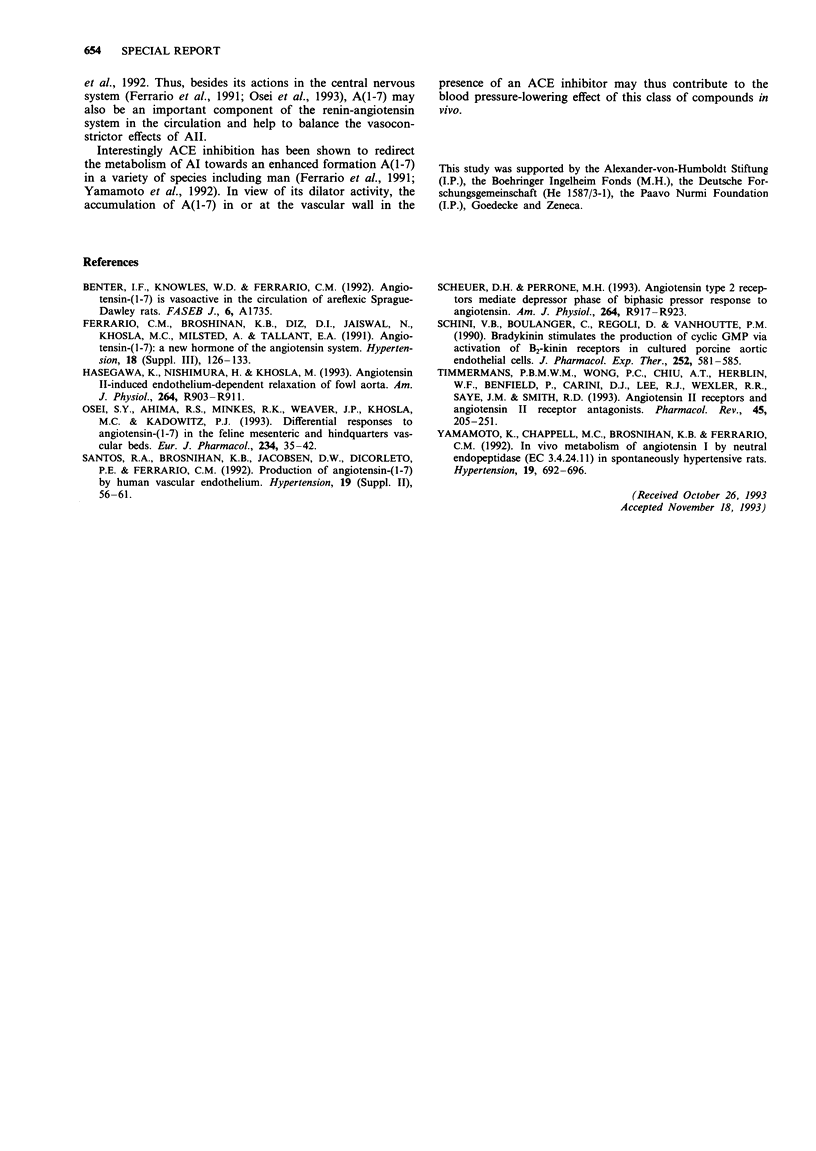Abstract
The angiotensin I (AI) metabolite, A(1-7), elicited a concentration-dependent dilator response (ED50 > or = 2 microM) in porcine coronary artery rings which was markedly attenuated by the nitric oxide (NO) synthase inhibitor, NG-nitro-L-arginine, and abolished after removal of the endothelium. This effect of the heptapeptide was not mimicked by AII, AIII or A(3-8) at comparable concentrations. The A(1-7)-induced relaxation was not affected by AT1 or AT2 receptor blockade or cyclo-oxygenase inhibition, but was attenuated by the B2 receptor antagonist, Hoe 140, and augmented by the angiotensin-converting enzyme (ACE) inhibitor, quinaprilat. These findings suggest that the relaxation to A(1-7) was mediated by the release of NO from the coronary endothelium through activation of an, as yet unidentified, AT receptor, the occupation of which also seems to stimulate the release of vasoactive kinins. Since A(1-7) accumulates during ACE inhibition, this mechanism may contribute to the coronary dilator effect of ACE inhibitors in vivo.
Full text
PDF


Selected References
These references are in PubMed. This may not be the complete list of references from this article.
- DiBona G. F., Jones S. Y. Arterial baroreceptor reflex function in borderline hypertensive rats. Hypertension. 1992 Jan;19(1):56–61. doi: 10.1161/01.hyp.19.1.56. [DOI] [PubMed] [Google Scholar]
- Hasegawa K., Nishimura H., Khosla M. C. Angiotensin II-induced endothelium-dependent relaxation of fowl aorta. Am J Physiol. 1993 May;264(5 Pt 2):R903–R911. doi: 10.1152/ajpregu.1993.264.5.R903. [DOI] [PubMed] [Google Scholar]
- Osei S. Y., Ahima R. S., Minkes R. K., Weaver J. P., Khosla M. C., Kadowitz P. J. Differential responses to angiotensin-(1-7) in the feline mesenteric and hindquarters vascular beds. Eur J Pharmacol. 1993 Mar 30;234(1):35–42. doi: 10.1016/0014-2999(93)90703-k. [DOI] [PubMed] [Google Scholar]
- Scheuer D. A., Perrone M. H. Angiotensin type 2 receptors mediate depressor phase of biphasic pressure response to angiotensin. Am J Physiol. 1993 May;264(5 Pt 2):R917–R923. doi: 10.1152/ajpregu.1993.264.5.R917. [DOI] [PubMed] [Google Scholar]
- Schini V. B., Boulanger C., Regoli D., Vanhoutte P. M. Bradykinin stimulates the production of cyclic GMP via activation of B2 kinin receptors in cultured porcine aortic endothelial cells. J Pharmacol Exp Ther. 1990 Feb;252(2):581–585. [PubMed] [Google Scholar]
- Timmermans P. B., Wong P. C., Chiu A. T., Herblin W. F., Benfield P., Carini D. J., Lee R. J., Wexler R. R., Saye J. A., Smith R. D. Angiotensin II receptors and angiotensin II receptor antagonists. Pharmacol Rev. 1993 Jun;45(2):205–251. [PubMed] [Google Scholar]
- Yamamoto K., Chappell M. C., Brosnihan K. B., Ferrario C. M. In vivo metabolism of angiotensin I by neutral endopeptidase (EC 3.4.24.11) in spontaneously hypertensive rats. Hypertension. 1992 Jun;19(6 Pt 2):692–696. doi: 10.1161/01.hyp.19.6.692. [DOI] [PubMed] [Google Scholar]


